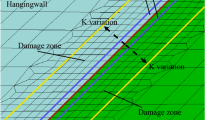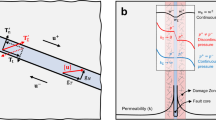Abstract
Assessing the intensity of potential seismicity induced by fault slip is a mandatory task in the development of enhanced geothermal systems. In this paper numerical simulations are performed to investigate the propagation of hydraulic fractures and the slip behavior of existing faults due to fluid injection. The cohesive zone model is used in combination with finite cohesive elements to model the hydraulic fractures and the existing faults while the fault shear strength is assumed to follow the Coulomb friction law. Our focus is on the role of the friction conditions on the fault slip behavior. The simulation results show that faults with small friction coefficients tend to slip at low slip rates while faults with a higher friction coefficient tend to slip at rates that are higher than the unstable slip rate threshold. It is also demonstrated that under specific frictional conditions, the sequential stimulation mechanism of permeability enhancement is possible. The results suggest that a good characterization of the fault frictional conditions is required to successfully predict the fault slip pattern and that lowering the fault friction coefficient could potentially reduce the fault slip rate.












Similar content being viewed by others
Explore related subjects
Discover the latest articles, news and stories from top researchers in related subjects.References
ABAQUS (2016) Analysis user’s manual version R2016. Dassault Système, Vélizy-Villacoublay
Baisch S, Weidler R, Vörös R, Wyborn D, de Graaf L (2006) Induced seismicity during the stimulation of a geothermal HFR reservoir in the Cooper Basin, Australia. Bull Seismol Soc Am 96:2242–2256
Barenblatt GI (1962) The mathematical theory of equilibrium cracks in brittle fracture. Adv Appl Mech 7:55–129
Bruel D (2007) Using the migration of the induced seismicity as a constraint for fractured Hot Dry Rock reservoir modelling. Int J Rock Mech Min Sci 44:1106–1117
Cappa F, Rutqvist J (2011) Modeling of coupled deformation and permeability evolution during fault reactivation induced by deep underground injection of CO2. Int J Greenh Gas Control 5:336–346
Carrier B, Granet S (2012) Numerical modeling of hydraulic fracture problem in permeable medium using cohesive zone model. Eng Fract Mech 79:312–328
Carter E (1957) Optimum fluid characteristics for fracture extension. In: Howard GC, Fast C (eds) Drilling and production practice. American Petroleum Institute, Washington
Cornet FH (2015) Elements of crustal geomechanics. Cambridge University Press, Cambridge
Coussy O (2004) Poromechanics. Wiley, London
Cuenot N, Dorbath C, Dorbath L (2008) Analysis of the microseismicity induced by fluid injections at the EGS site of Soultz-sous-Forêts (Alsace, France): implications for the characterization of the geothermal reservoir properties. Pure Appl Geophys 165:797–828
Cueto-Felgueroso L, Santillán D, Mosquera JC (2017) Stick-slip dynamics of flow-induced seismicity on rate and state faults. Geophys Res Lett 44:4098–4106
Detournay E (2016) Mechanics of hydraulic fractures. Annu Rev Fluid Mech 48:311–339
Dieterich JH (1972) Time-dependent friction in rocks. J Geophys Res 77:3690–3697
Dieterich JH (1979) Modeling of rock friction: 1. Experimental results and constitutive equations. J Geophys Res Solid Earth 84:2161–2168
Dorbath L, Cuenot N, Genter A, Frogneux M (2009) Seismic response of the fractured and faulted granite of Soultz-sous-Forêts (France) to 5 km deep massive water injections. Geophys J Int 177:653–675
Dublanchet P, Bernard P, Favreau P (2013) Interactions and triggering in a 3-D rate-and-state asperity model. J Geophys Res Solid Earth 118:2225–2245
Dugdale DS (1960) Yielding of steel sheets containing slits. J Mech Phys Solids 8:100–104
Ellsworth WL (2013) Injection-induced earthquakes. Science 341:6142
Engelder JT, Scholz CH (1976) The role of asperity indentation and ploughing in rock friction—II: Influence of relative hardness and normal load. Int J Rock Mech Min Sci Geomech Abstr 13:155–163
Evans KF, Zappone A, Kraft T, Deichmann N, Moia F (2012) A survey of the induced seismic responses to fluid injection in geothermal and CO2 reservoirs in Europe. Geothermics 41:30–54
Gaucher E, Schoenball M, Heidbach O, Zang A, Fokker PA, van Wees J-D, Kohl T (2015) Induced seismicity in geothermal reservoirs: a review of forecasting approaches. Renew Sustain Energy Rev 52:1473–1490
Ghassemi A, Tarasovs S (2015) Analysis of fracture propagation under thermal stress in geothermal reservoirs. In: Proceedings world geothermal congress 2015, Melbourne, Australia
Grigoli F, Cesca S, Rinaldi A, Manconi A, López-Comino J, Clinton J, Westaway R, Cauzzi C, Dahm T, Wiemer S (2018) The november 2017 Mw 5.5 Pohang earthquake: a possible case of induced seismicity in South Korea. Science 360:1003–1006
Häring MO, Schanz U, Ladner F, Dyer BC (2008) Characterisation of the Basel 1 enhanced geothermal system. Geothermics 37:469–495
Hillerborg A, Modéer M, Petersson PE (1976) Analysis of crack formation and crack growth in concrete by means of fracture mechanics and finite elements. Cem Concr Res 6:773–781
Jaeger JC, Cook NG, Zimmerman R (2009) Fundamentals of rock mechanics. Wiley, New York
Jeanne P, Rutqvist J, Dobson PF (2017) Influence of injection-induced cooling on deviatoric stress and shear reactivation of preexisting fractures in enhanced geothermal systems. Geothermics 70:367–375
Keshavarz M (2009) Contribution to experimental study of mechanical and thermal damage in crystalline hard rocks. PhD dissertation, Université Joseph Fourier-Grenoble I
Li Y, Deng JG, Liu W, Feng Y (2017) Modeling hydraulic fracture propagation using cohesive zone model equipped with frictional contact capability. Comput Geotech 91:58–70
McClure MW, Horne RN (2011) Investigation of injection-induced seismicity using a coupled fluid flow and rate/state friction model. Geophysics 76:WC181–WC198
Meyer G, Baujard C, Hehn R, Genter A, McClure M (2017) Analysis and numerical modelling of pressure drops observed during hydraulic stimulation of GRT-1 geothermal well (Rittershoffen, France). In: Proceedings 42nd workshop on geothermal reservoir engineering. Stanford University, Stanford, CA
Ngo DT, Pellet FL (2018) Numerical modeling of thermally-induced fractures in a large rock salt mass. J Rock Mech Geotech Eng 10:844
Niitsuma H, Fehler M, Jones R, Wilson S, Albright J, Green A, Baria R, Hayashi K, Kaieda H, Tezuka K, Jupe A, Wallroth T, Cornet F, Asanuma H, Moriya H, Nagano K, Phillips WS, Rutledge J, House L, Beauce A, Alde D, Aster R (1999) Current status of seismic and borehole measurements for HDR/HWR development. Geothermics 28:475–490
Pellet FL (2017) Rock mechanics is meeting the challenges of geo-energies. Proc Eng 191:1104–1107
Pellet FL, Keshavarz M, Amini-Hosseini K (2011) Mechanical damage of a crystalline rock having experienced ultra high deviatoric stress up to 1.7 GPa. Int J Rock Mech Min Sci 48:1364–1368
Ruina A (1983) Slip instability and state variable friction laws. J Geophys Res Solid Earth 88:10359–10370
Scuderi MM, Collettini C, Marone C (2017) Frictional stability and earthquake triggering during fluid pressure stimulation of an experimental fault. Earth Planet Sci Lett 477:84–96
Segall P (2010) earthquake and volcano deformation. Princeton University Press, Princeton
Selvadurai APS, Suvorov AP (2016) Thermo-poroelasticity and geomechanics. Cambridge University Press, Cambridge
Stober I, Bucher K (2007) Hydraulic properties of the crystalline basement. Hydrogeol J 15:213–224
Turon A, Dávila CG, Camanho PP, Costa J (2007) An engineering solution for mesh size effects in the simulation of delamination using cohesive zone models. Eng Fract Mech 74:1665–1682
Wang Y, Hu X (2017) Determination of tensile strength and fracture toughness of granite using notched three-point-bend samples. Rock Mech Rock Eng 50:17–28
Wohlenberg J, Keppler H (1987) Monitoring and interpretation of seismic observations in hot dry rock geothermal energy systems. Geothermics 16:441–445
Yao Y (2012) Linear elastic and cohesive fracture analysis to model hydraulic fracture in brittle and ductile rocks. Rock Mech Rock Eng 45:375–387
Acknowledgements
The authors would like to thank the GEOTREF project for financial support (www.geotref.com). This project is funded by ADEME within the “Les Investissements d’Avenir” Program. Partners of the GEOTREF project include Teranov, Kidova, MINES ParisTech, ENS Paris, GeoAzur, Georessources, IMFT, IPGS, LHyGes, UAG, and UCP-GEC. The authors also express their gratitude to the Dassault Système Foundation, which also supported this study.
Author information
Authors and Affiliations
Corresponding author
Ethics declarations
Conflict of interest
The authors wish to confirm that there are no known conflicts of interest associated with this publication and there has been no significant financial support for this work that could have influenced its outcome.
Additional information
Publisher's Note
Springer Nature remains neutral with regard to jurisdictional claims in published maps and institutional affiliations.
Rights and permissions
About this article
Cite this article
Ngo, D.T., Pellet, F.L. & Bruel, D. Modeling of fault slip during hydraulic stimulation in a naturally fractured medium. Geomech. Geophys. Geo-energ. Geo-resour. 5, 237–251 (2019). https://doi.org/10.1007/s40948-019-00108-1
Received:
Accepted:
Published:
Issue Date:
DOI: https://doi.org/10.1007/s40948-019-00108-1




